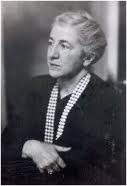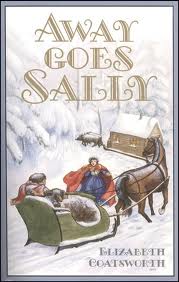Elizabeth Coatsworth facts for kids
Quick facts for kids
Elizabeth Coatsworth
|
|
|---|---|

Coatsworth
|
|
| Born | Elizabeth Jane Coatsworth May 31, 1893 Buffalo, New York, US |
| Died | August 31, 1986 Nobleboro, Maine, US |
| Resting place | Nobleboro, Maine |
| Occupation | Writer |
| Education | Master of Arts |
| Alma mater | Columbia University |
| Genre | Children's and adult novels, picture books, poetry |
| Notable works |
|
| Notable awards | Newbery Medal 1931 |
Elizabeth Jane Coatsworth (born May 31, 1893 – died August 31, 1986) was an American writer. She wrote many stories and poems for both children and adults. She is famous for winning the 1931 Newbery Medal. This award from the American Library Association award honored her book The Cat Who Went to Heaven. It was chosen as the best children's book published the year before. In 1968, she was also recognized internationally. She was a highly praised runner-up for the Hans Christian Andersen Award, which celebrates children's writers.
Contents
Her Life Story
Elizabeth Coatsworth was born on May 31, 1893, in Buffalo, New York. Her parents were Ida Reid and William T. Coatsworth. Her father was a successful grain merchant. Elizabeth went to Buffalo Seminary, a private school for girls. During the summers, her family would spend time by Lake Erie in Canada.
She started traveling at a very young age. When she was only five, she visited the Alps mountains and Egypt! After high school, she went to Vassar College and graduated in 1915. In 1916, she earned a Master of Arts degree from Columbia University. After her studies, she traveled even more. She explored eastern Asia, riding horses in the Philippines. She also visited Indonesia and China, and even slept in a Buddhist monastery. These amazing trips later inspired many of her stories.
In 1929, Elizabeth married another writer named Henry Beston. They had two daughters, Margaret and Catherine. The family lived in Hingham, Massachusetts, and also at Chimney Farm in Nobleboro, Maine. Their daughter, Kate Barnes (1932–2013), also became a talented writer. She was even named the first Poet Laureate of Maine.
Elizabeth Coatsworth passed away at her home in Nobleboro, Maine, on August 31, 1986.
Her Amazing Writing Journey
Elizabeth Coatsworth began her writing career by publishing poems in magazines. Her first book, Fox Footprints, was a collection of poetry for adults. It came out in 1912.
A friend named Louise Seaman Bechtel encouraged her to write for children. Louise had just started the first children's book publishing department in the United States at Macmillan. This led Elizabeth to write her first children's book, The Cat and the Captain.
In 1930, her famous book The Cat Who Went to Heaven was published. This story is about an artist painting a picture of Buddha for a group of monks. It won the Newbery Medal, a very important award for children's literature.
Elizabeth Coatsworth had a very long and successful career. She published over 90 books! Her first book came out in 1910, and her last book, her autobiography, was published in 1976.
Books She Wrote
For Young Readers
- The Cat and the Captain, illustrated by Gertrude Kaye, Macmillan, 1927
- The Cat Who Went to Heaven, ill. Lynd Ward Macmillan, 1930
- The Golden Horseshoe, ill. Robert Lawson, Macmillan, 1935
- Sword of the Wilderness, ill. Harve Stein, Macmillan, 1936
- Alice-All-by-Herself, ill. Marguerite de Angeli, Macmillan, 1937
- Dancing Tom, ill. Grace Paull, Macmillan, 1938
- You Shall have a Carriage, ill. Henry Clarence Pitz, Macmillan, 1941
- Runaway Home, ill. Gustaf Tenggren, Row, Peterson and Company, 1942
- Indian Mound Farm, ill. Fermin Rocker, Macmillan, 1943
- Up Hill and Down: Stories, ill. James Davis, Knopf, 1947
- Night and the Cat, With Illustrations by Foujita, Macmillan, 1950
- Dollars for Luck, ill. George and Doris Hauman, Macmillan, 1951; reissued as The Sailing Hatrack, London:Blackie, 1972
- Cat Stories, ill. Feodor Stepanovich Rojankovsky, Simon & Schuster, 1953
- Dog Stories, ill. Rojankovsky, Simon & Schuster, 1953
- Old Whirlwind: The Story of Davy Crockett, ill. Manning Lee, Macmillan, 1953
- Horse Stories, by Kate Barnes and Coatsworth, ill. Rojankovsky, Simon & Schuster, 1954
- The Peddler's Cart, by Eliabeth Coatsworth, ill. Zhenya Gay, Macmillan, 1956
- Pika and the Roses, ill. Kurt Wiese, Pantheon, 1959
- Lonely Maria, ill. Evaline Ness, Pantheon, 1960
- The Noble Doll, ill. Leo Politi, Viking, 1961
- Chimney Farm Bedtime Stories, by Henry Beston and Coatsworth, ill. Maurice Day, Holt, Reinhart, 1966
- The Lucky Ones:Five Journeys Toward a Home, ill. Janet Doyle, Macmillan, 1968
- Under the Green Willow, ill Janina Domanska, Macmillan, 1971
- The Wanderers, ill. Trina Schart Hyman, Scholastic, 1972
- Pure Magic, ill. Ingrid Fetz, Macmillan 1973; reissued as The Werefox, Collier, 1975
- Marra's World, ill. Krystayna Turska, Greenwillow, 1975
The Sally Series
These five historical novels about a character named "Sally" were all illustrated by Helen Sewell and published by Macmillan US.
- Away Goes Sally, 1934
- Five Bushel Farm, 1938
- The Fair American ,1940
- The White Horse , 1942
- The Wonderful Day, 1946
For Adults
Novels
- Here I Stay, Coward McCann, 1938
- The Trunk, Macmillan, 1941
Incredible Tales
- The Enchanted, Pantheon, 1951
- Silky: An Incredible Tale, Pantheon, 1953
- Mountain Bride: An Incredible Tale, Pantheon 1954
- The White Room, Pantheon, 1958
Poetry
- Fox Footprints, Knopf, 1923, poetry
- Country Poems, Macmillan, 1942
- The Creaking Stair, Coward McCann, 1949
Other Books
- The Sun's Diary: A Book of Days for Any Year, Macmillan, 1929
- Country Neighborhood, Macmillan, 1945
- Maine Ways, Macmillan, 1947
- Especially Maine: The Natural World of Henry Beston from Cape Cod to the St. Lawrence; (editor), Stephen Greene, 1970
- Personal Geography: Almost an Autobiography, Stephen Greene, 1976


